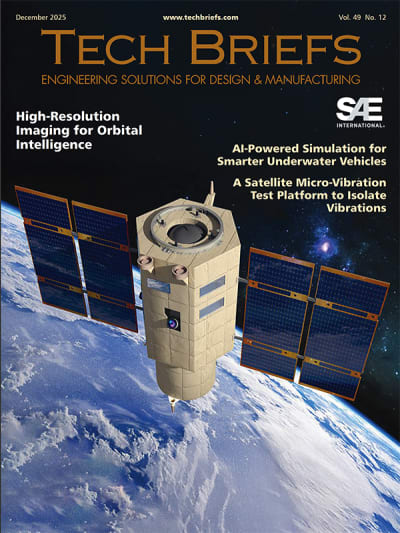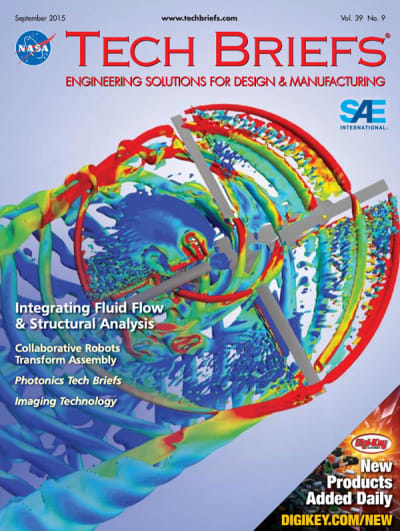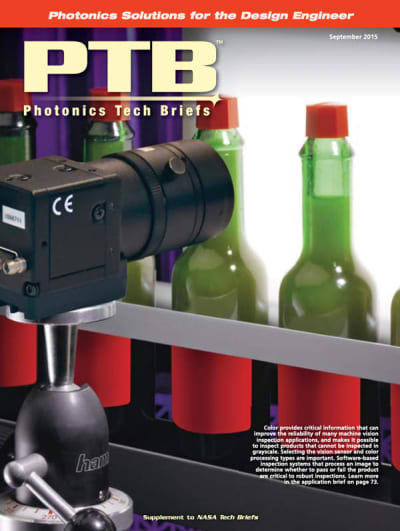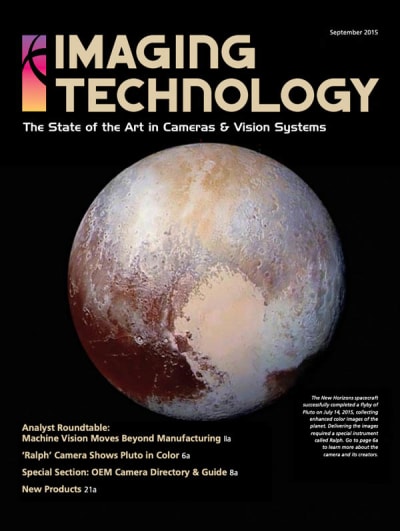Inside this issue
Overview
The September 2015 issue of NASA Tech Briefs, along with its supplements, presents a wealth of information on advancements in technology, particularly in the fields of motion control, photonics, imaging technology, and automation. This edition highlights several key themes and innovations that are shaping the future of engineering and technology.
Collaborative Robots in Assembly
One of the standout features of this issue is the focus on collaborative robots, or cobots, which are designed to work alongside human operators in assembly processes. These robots enhance productivity and efficiency by taking on repetitive or physically demanding tasks, allowing human workers to focus on more complex and creative aspects of production. The article discusses various applications of cobots in manufacturing environments, emphasizing their ability to improve workflow and reduce the risk of injury for human workers.
Machine Vision and Color Processing
The issue also delves into the advancements in machine vision technology, particularly the importance of color in inspection applications. Color provides critical information that enhances the reliability of machine vision systems, enabling the inspection of products that cannot be adequately assessed using grayscale imaging. The magazine discusses the selection of vision sensors and color processing techniques, highlighting the significance of software-based inspection systems that analyze images to determine product quality. This technology is crucial for industries where precision and quality control are paramount.
The New Horizons Mission
A significant highlight of this issue is the coverage of NASA's New Horizons spacecraft, which successfully completed its historic flyby of Pluto on July 14, 2015. The spacecraft captured enhanced color images of the dwarf planet, providing unprecedented views of its surface and atmosphere. The magazine features an in-depth look at the Ralph camera, the specialized instrument responsible for capturing these stunning images. This mission not only expanded our understanding of Pluto but also showcased the capabilities of modern imaging technology in space exploration.
Innovations in Imaging Technology
In addition to the New Horizons mission, the issue includes a special section dedicated to imaging technology innovations. This section features a directory and guide to OEM cameras, highlighting new products and technologies that are making waves in the industry. The advancements in imaging technology are critical for various applications, from scientific research to industrial automation, and the magazine provides insights into the latest trends and developments in this field.
Fluid Flow and Structural Analysis
Another important topic covered in this issue is the integration of fluid flow and structural analysis. The magazine discusses how these two areas of study can be combined to improve the design and performance of engineering systems. By understanding the interactions between fluid dynamics and structural integrity, engineers can create more efficient and reliable products. This integration is particularly relevant in industries such as aerospace, automotive, and civil engineering, where performance and safety are of utmost importance.
New Products and Technologies
The September 2015 issue also features a section on new products, showcasing the latest innovations in technology. This includes a variety of tools, software, and systems designed to enhance productivity and efficiency in engineering and manufacturing processes. The magazine provides detailed descriptions of these products, along with their applications and benefits, making it a valuable resource for engineers and designers looking to stay updated on the latest advancements.
Conclusion
Overall, the September 2015 issue of NASA Tech Briefs and its supplements offer a comprehensive overview of the latest trends and innovations in technology. From collaborative robots and machine vision to groundbreaking space exploration and imaging technology, this edition highlights the critical advancements that are shaping the future of engineering. The insights provided in this issue are not only informative but also serve as inspiration for engineers and technologists seeking to push the boundaries of what is possible in their respective fields. Whether you are involved in manufacturing, research, or technology development, this issue is a must-read for anyone interested in the cutting-edge advancements that are driving progress in the industry.
Features
-
Application Briefs
Computer and Displays Help Control and Maneuver Crew Transportation System
Tech Briefs
-
Machinery & Automation
3D Motor for Multi-Axis Attitude Control on SmallSats
Nanosatellite Launch Adapter System
Visual Environment for Remote Virtual Exploration (VERVE) v2
Optimal Alarm System Design and Implementation
Mars Science Laboratory Flight Software for Autonomous Drilling
Morpheus Lander Vehicle Simulation/Vehicle Flight Software
Risk-Aware Mars Rover Operation Tool with Autonomous Terrain Classifier and Path Planner
-
Materials
Mechanical Carbon Materials for Aircraft Seal Applications
Strong and Flexible Carbon Fiber Reinforced Phenolic Composites
Hybrid Laminate Composite for Harsh Environments and High-Performance Applications
Surface-Modified Nanoparticles Made From High-Molecular-Weight Carboxylic Acids
NASA PS400 High-Temperature Solid Lubricant Coating
Triple Orthogonal Disk Polymer Discrete Space for Cryogenic Feedline Insulation
Compliant Electrode and Composite Materials for Piezoelectric Wind and Mechanical Energy Conversion
Development of a Novel, Regenerable Microlith Catalytic Reactor for CO2 Reduction via Bosch Process
-
Information Sciences
Fast Block Transforms on Large Binary Datasets in the Cloud Using Hadoop Streaming
Mars Science Laboratory Frame Manager
SIVO-PyD: A Python Distribution for Scientific Computing Visualization
Formal Validation of Model-Based Fault Management Design Solutions
Development of Free Molecule Flow Equations from a Transient, Asymmetric Source
iPhone App to Facilitate Airborne Radar Operations
Spherical Empirical Mode Decomposition
Database Design for Storing Software Entity Metadata, User Identification, and License Terms
-
Sensors/Data Acquisition
Position Sensor Technology for Hydraulic Cylinder Feedback
Detection of Gases and Vapors Present at Low Concentrations
Broadband Photon-Counting Microwave Kinetic Inductance Detector
Micro-LIDAR for Flow Velocimetry
Sensitive, Specific Molecular Detection of Single Bacteria Cells
Optical Hotspot Conductive Fluid Flow Sensor
Free-Space, Coupled, Multi- Element Detector for Deep Space Optical Communication
-
Aerospace
Robust, Optimal Subsonic Airfoil Shapes
Merging and Spacing Software in the ACES Simulation
Unmanned Aerial Vehicle Integration into the National Airspace System
Data Server for Real-Time Display Interface
Aircraft Wing Flap Noise-Reducing Fins
Direct Multiple Shooting Optimization with Variable Problem Parameters
-
Communications
Digitally Steered Phased Antenna Array for GPS Applications
Broadband Circularly Polarized Antenna Array for Mars Rover Direct-to-Earth Communications
Robust, Low-Density Parity- Check Decoder Design to Mitigate Pulsed Radio Frequency Interference
Products
-
Applications
-
Applications





